Daunted at the thought of office relocation? Before we delve into how best to plan the ins and outs of it your office relocation, we believe that a hearty congratulations is in order. An office relocation is the perfect way to start fresh, and a completely blank canvas means that you can kit out your brand new office space as you please. However, in order to keep stress levels to a minimum – as well as avoiding disruption to business operations – strategic planning, organisation and attention to detail are essential.
Here at Diamond Interiors, you could say that office relocation is our forte – just check out our projects! We’ve been helping companies with the big move for more than 20 years, enabling a smooth transition from start to finish. When paired with our office refurbishment or interior design service, you’ll have everything you need to inject some life into your workspace – which is surely what every business owner strives for. Whether you’re expanding (or downsizing!), wanting to improve company culture, rebrand and revitalise – we’re here to ensure a seamless process. In this complete guide to office relocation, you’ll find everything you need to see you through the full transition.
When should you start planning your office relocation?
First things first, how far in advance should you be planning your office move? Ultimately, this will depend on the project’s scale, with larger projects generally requiring more preparation than smaller ones. However, a general formula to follow is to plan 12 months in advance for a 10,000 square foot project; for a 5,000 square foot project, we recommend you plan 6 months in advance. Just remember that it’s always better to be overprepared, rather than risking making rash, last-minute decisions, which could make your office relocation more rocky seas than smooth sailing. You’ll also want to make plans to lessen the impact of office relocation – such as staggering the stages of your move, incorporating hybrid (or remote) working, and anything else that can reduce the impact on daily operations.
Your office relocation checklist
Need a hand getting both yourself and your team on track for the big office move? Tick off everything in our office relocation checklist below as you go along!
Over 12 months before the moving date
- Terminate your current lease
- Nominate a project leader
- Prepare internal team
- Establish relocation objectives
- Design a workplace strategy
- Partner with an office relocation company
- Define space requirements
- Set budgets and costs
12-9 months before the moving date
- Find your new workspace
- Survey site
- Ensure all paperwork is signed
9-6 months before the moving date
- Find an office relocation and design company
- Decide on furniture and decor
- Communicate move with stakeholders
- Ensure departments are kept up to date
3-6 months before the moving date
- Set your moving date in stone
- Establish your planning team
2-3 months before the moving date
- Create a list of everyone that needs to be notified of the new office address
- Allocate desk space to each employee
- Book cleaning service to deep clean both your current and new office
4 weeks before moving day
- Create detailed plan for moving day for your staff
- Make a list of emergency contact numbers
2-3 weeks before moving day
- Confirm removal company
- Organise food and drink delivery to new office
- Confirm internet, phone lines and bills will all be in place when you arrive
- Set up post and phone call forwarding
One week before the moving date
- Delegate tasks to moving team to oversee packing process
- Share moving packs with each employee
- Organise and pack current office furniture
- Label and colour code moving boxes
- Remind staff to collect personal belongings
- Designate employees to be at the new office on moving day
Moving day
- Have budget set aside for refreshments for moving team
- Ensure tech equipment is moved and installed
- Have people organise furniture in the new office, based on the floor plan
- Hand out keys and fobs for new office
- Remind staff not to turn up at the old office
Post-move
- Update website information
- Check furniture
- Make sure previous deposit has been refunded
- Send back keys, fobs and passes to old office
- Celebrate!
Over 12 months before the moving date
1. Terminating your lease
Before you start preparing for the big move, remember to check when your current lease will terminate within your commercial property’s leasing contract. Knowing this information will allow you to set an official moving date, alongside providing a clearer timescale, which will help you to prioritise tasks. Next, you’ll need to serve notice to the property manager and establish whether there’s a break clause (which may allow you to leave earlier) and what the notice period is.
2. Nominating a project leader

Who will be overseeing your office relocation? Arguably, the person you choose could either make or break this project, so choose carefully.
With this in mind, what are the main traits you should look for in a potential relocation project leader?
Team-building skills
Having the vital responsibility of delegating tasks to specific members of the team, and ensuring that these tasks are completed efficiently, makes team-building skills a crucial trait of your relocation project leader. Your employees will need to work together throughout the project to get the job done quicker, so your project leader’s ability to bring heads together will enable a seamless transition.
Communication
Communication is also essential for your relocation to run smoothly, so if your project leader possesses this key trait, you’re onto a winner. They’ll need to converse with individuals both internally and externally to ensure that everyone knows what’s going on, and the ability to clearly relay crucial information about the move is a must.
Time management
We certainly couldn’t miss this one off the list. A project leader with good time management skills is more likely to work efficiently within set timeframes and in a calm manner. They’ll also be able to prioritise tasks with ease, making for a stress-free moving experience.
Organisation
The ability to organise moving tasks, as well as getting a team organised, will also contribute to a smoother process. If your project leader is able to think clearly under pressure, knows exactly what needs to be done and when, and is able to remain level-headed throughout the relocation, this will give all those involved more confidence.
Motivation
Project leaders who are keen to get cracking with an office relocation are more likely to motivate the wider team, reinforcing the idea that a move is an incredibly beneficial event for any business. Armed with a clear business vision, their ability to determine what’s best for your company and how to further improve will produce exceptional results.
Budgeting
Do they have previous experience working within tight budgets? The ability to spend within their means will ensure that the project is a cost-effective one.
3. Prepare internal team
When it comes to guaranteeing a successful office relocation, every team has a role to play. From establishing an operations team to ensure that regular business operations don’t come to a standstill during the move, to getting your finance team working to a strict budget. Not to mention, you can utilise your marketing team’s design skills, along with their strong understanding of your brand, to ensure that your new office captures your essence perfectly.
4. Establish relocation objectives
Next up, it’s time to establish your relocation objectives – really get to grips with the main reasons for your move. Defining this, both from a financial and business growth standpoint, will provide further clarity when deciding on next steps, so you can get the most out of your move.
Some of your main moving objectives might be:
- A business refresh
- Optimise worker motivation
- Improve staff retention
- Cater for a growing business
- Reducing expenditure
- Research into traditional vs modern office design
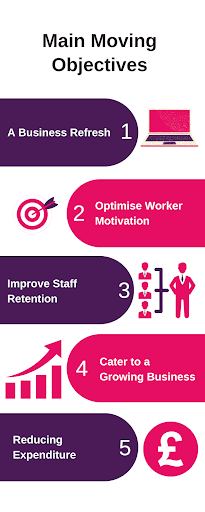
5. Design a workplace strategy
If you feel as though your current workplace is lacking, designing a workplace strategy will ensure that your new space takes your business to the next level. For example, how effectively are you utilising the area? Are your staff able to complete tasks efficiently? Are you protecting their wellbeing? Although you may not think it, a person’s environment can drastically affect their productivity levels, with poor office design causing motivation to be at an all-time low – so really have a think about ergonomic office design!
Think of your office relocation as the chance to completely refresh your business, and a way to inject a new lease of life into your surroundings. Communicate with your employees to understand exactly which areas your current office is lacking in – whether there’s not enough space, or that more could be done to support team working activities – and brainstorm the key elements to be incorporated into your workplace strategy. Just take a look at our office design for different industries post if you’re looking for a starting point and some inspiration!
6. Partner with an office relocation company
To make the transition into your new workspace as smooth and stress-free as possible, you could consult an office relocation company – which is where we come in. Whatever your reasons for relocating, our team of experts will work with you every step of the way to help you discover a space that goes above and beyond your expectations. Our service will involve:
- Building appraisal
- Space planning
- Budget cost planning
- Surveys
7. Define space requirements
Before conquering the workspace market, you must firstly establish how much space you’ll need to fit everyone comfortably into your new office. From ensuring sufficient desk space, to setting space aside for office storage solutions – preventing dreaded clutter build-up – make sure to avoid your staff feeling like sardines in a tin. Whether you’re planning on upsizing or downsizing, there are a variety of ways to fulfil your office design dreams, minus the stress.
Thankfully, when moving day finally arrives, there are certain design techniques you can adopt to maximise office space. Taking our full interior fit out for Humanscale as the perfect example, under-the-desk storage enables staff to keep their workspace nice and tidy, ensuring that productivity stays at an all-time high.
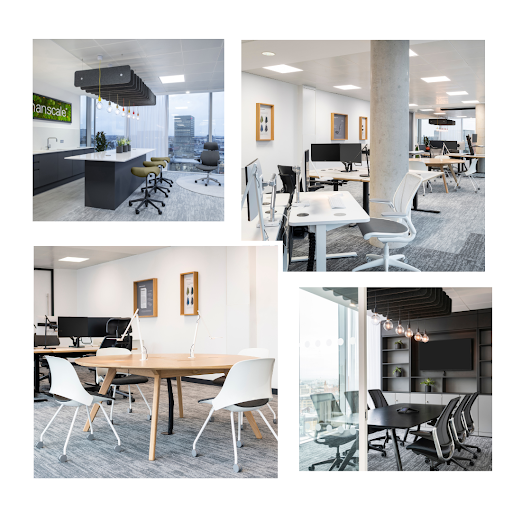
Alternatively, wall storage may be a more preferable option, which will also enable you to fill your floor space with plenty of new office furniture – without the worry of taking up too much space. NR Barton had similar requirements, and we made sure that their new workspace was as practical as it was aesthetically pleasing.

9. Set budgets and costs
Moving offices can become costly, which is why organisation is key to ensuring that your money is directed into the right places, whilst spending within your limits. To aid your assigned project manager in setting appropriate budgets, it’s helpful to firstly establish your separate moving expenses. Your budgeting checklist could include the following:
- Deposit for new office
- First month’s rent for new office
- Initial utility bills
- Maintenance costs
- Refurbishment costs
- Damage costs
- New office equipment
- Internet
- Insurance for new office
- Cleaners
- Solicitor to oversee transactions
- Removal costs
- Temporary storage solution
- Recruitment
- Staff overtime
- Advertising
- Rubbish disposal
- Construction work and repairs
12-9 months before the moving date
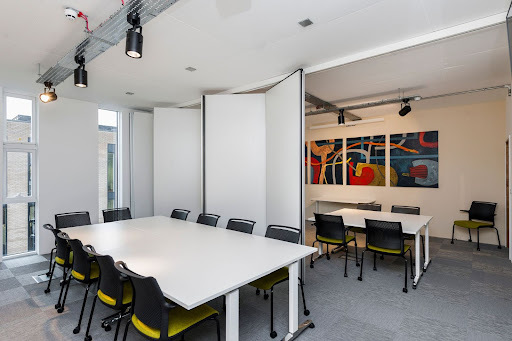
1. Find your new workplace
Now onto the exciting bit – choosing the new office workplace of your dreams. This decision is a crucial one, so what are the key factors to bear in mind before making your choice?
Location
How accessible is the workplace? An office that’s positioned close to major transport links is a must, as not only will this impact employee satisfaction, productivity levels could drop due to late arrivals or stressful commutes. With a study revealing that 57% of UK workers deem a job’s location as being more important than their wage, winding up in the middle of nowhere is likely to halt, or even lower business growth – which definitely isn’t what you want.
Space
The amount of space you require from a new workplace will vary depending on your number of employees. On the one hand, you’ll need to avoid staff feeling cramped as this could impact both wellbeing and productivity, but it’s just as important that you don’t end up with too much space – which is unnecessary expenditure. Try to opt for a happy medium.
Layout and design
As amazing as it will be to see your office design dreams come true, a change in workspace layout is also a great way to revitalise your staff, keeping them motivated and productive. However, failing to provide for their needs will have an adverse effect on employee wellbeing, so make your choice carefully. Al Horr et al (2016) evaluated the link between indoor environmental quality and office productivity and the results speak for themselves. Factors such as air quality, lighting and biophilia (being close to nature) were found to impact the number of sickness days taken and staff turnover, as well as employee satisfaction and productivity. So, all of this – and more – must be considered before making the final decision. If you’re looking for more inspiration on how you can design your office to maximise productivity, our previous article will tell you everything you need to know.
Get a second opinion
Deciding on your office space can be daunting, so collaborating with your team is one way to take the load off. Organise a meeting to establish what your staff are looking for in a new workplace – for example, would they like to see more collaborative or break out areas? Would they benefit from a shared kitchen? How do they find the office’s current location? The decision will have a big impact on their day-to-day life, and they’ll value you taking their opinions into account.
2. Site Survey
Now that you’ve discovered your dream office, complete a site survey to ensure that you have everything you need prior to moving day. If this isn’t done, you could be risking your staff’s health and safety. You can rely on the help of a specialist to evaluate the following for you:
- Is the site secure?
- Is it fire protected?
- Are there appropriate lighting levels both inside and outside?
- How energy efficient is the site?
- What’s the overall condition like?
- Are there an appropriate number of stairways and lifts?
- How clean is the site?
3. Ensure all paperwork is signed
After negotiating the lease with the landlord of your new potential office, it’s time to get the ball rolling and sign those papers. By communicating with your legal team and a surveyor, you can ensure that you’re getting the most for your money.
9-6 months before the moving date

1. Find an office design company
Now you’ve got the building sorted, you can start designing and customising your new office as you please. However, if you’re in search of some expert advice to help make your desired aesthetic a reality, consulting an office design company is the best way forward. Regardless of your desired aesthetic, our team – backed with years of industry experience – can work with you to transform any environment. We’ll provide a full consultation service to ensure that you’re making the most of your available space, and then we can bring your ideas to life in an instant – thanks to our innovative 3D visualisation tool.
2. Decide on furniture and décor
Planning an office move is the perfect way to create a space that perfectly encapsulates your brand. With our bespoke office refurbishment service, we can help you to select the best furniture and decor to reflect this, making the whole process a completely stress-free and enjoyable experience. From hand-picking furniture that ticks off all of your needs, to both delivering and assembling items on your behalf, there’ll be no stone left unturned.
3. Communicating your office relocation
It’s essential that you communicate your office relocation to internal and external stakeholders, as well as to all teams and departments within the business, to ensure the continuation of regular operations. Also, by being completely transparent throughout, your staff will feel more inclined to engage with the moving process – making the transition much easier for everyone involved.
3-6 months before the moving date

1. Set your moving date in stone
Now that you’ve decided where you’re moving to, and how you’ll be decorating it, it’s time to decide on your official moving date. With preparations already in place, it should be easier to decide realistically when this will be, plus establishing ‘deadlines’ for when each relocation task needs to be completed will keep the process moving along efficiently.
2. Establish your planning team
With a moving date set in stone, work towards your target with the help of a planning team. By delegating tasks to individuals – from packing up office equipment, to ensuring that there will be individuals there to meet the removal team on moving day – tasks will instantly appear less daunting. Plus, a wider team makes for a speedier move.
2-3 months before the moving date
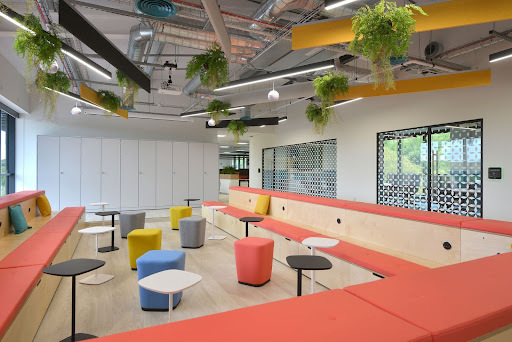
1. Create a list of everyone that needs to be notified of your new address
Before moving, make a detailed list of everyone – both internally and externally – who will need to be made aware of your new office address. This could include the following:
Financial
- Banks
- Credit card suppliers
- Pension providers
Services
- Tax advisers
- Accountants
- Insurance providers
- Legal advisers
- Professional institutions/associations
Customers and suppliers
- Clients
- Mobile and broadband providers
- IT hosting/backup services
- Staff – including those working remotely and on leave
- Affiliates
- Partners
- Tech companies e.g. servers, photocopiers, printers
Extras
- Contact details mentioned on your website
- Advertising – e.g. business cards, fliers
- Stationery providers
- Food and drinks services
2. Allocate desk space to each employee
Part of planning your office layout will involve allocating desk space to each employee – which is a task that is more important than you may first think. One of the worst things a staff member can be in the office is cramped, so ensure that each individual has plenty of space available to them. When you do create your seating plan, consider where team-working zones, individual seating and drop-in areas will be, sharing this with your staff beforehand to confirm that they’re happy with these arrangements.
3. Booking a cleaning service
Get both your new and old office spick and span by allocating a portion of your budget to a professional cleaning service. This way, you can guarantee that the new workspace is free of any dirt and grime, which certainly isn’t what you want for the grand opening. Plus, you’ll avoid paying additional fees for leaving your old office untidy.
4 weeks before moving day

1. Create a detailed plan for moving day
Delegate tasks for moving day to keep stress levels to a minimum. From packing and unpacking to furniture placements, establishing set teams will help make the job much quicker. Make a checklist of everything that needs to be done on the day to make sure that you’re working through each task as efficiently as possible.
2. Make a list of emergency contact numbers
These will need to be handed out to all those part of the moving team to be used in an emergency. Contacts could include:
- Building managers
- Maintenance staff
2-3 weeks before moving day

1. Confirm removal company
After you’ve asked for recommendations for the best local moving companies to use, you can narrow down your options by asking them the following questions:
- How much is their daily rate? Do they offer discounts for multiple days?
- How flexible can they be? Will they charge extra for early mornings or late nights?
- Ask them to point you in the direction of customer reviews
- Do they provide any additional services? E.g. cleaning up, helping to pack, supplying truck and boxes
2. Organise food and drink delivery to new office
Whether you’re planning on having a water dispenser or a drinks fridge in your new workspace, make sure you’re completely kitted out with plenty of snacks and refreshments before moving day.
3. Confirm internet, phone lines and bills are in place
To prevent any hiccups following moving day, confirm that your new internet, phone lines and bills are in place, ready for when work commences.
4. Set up post and phone call forwarding
If anyone – be it customers or clients – tries to contact your company whilst you’re moving, set up post and phone call forwarding to ensure that no messages get missed along the way.
One week before the moving date
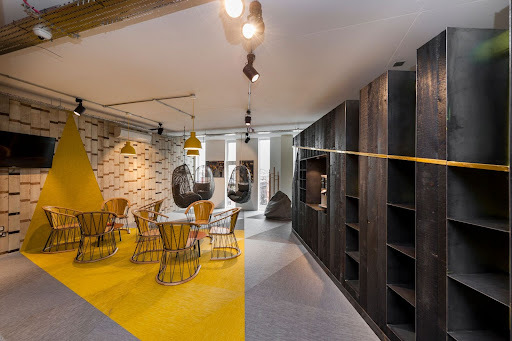
1. Share moving packs with each employee
As moving day nears closer, prepare – and excite – each member of staff by providing them with their own moving pack. This could include where their new desk will be, a handy crate to keep their belongings in, as well as all the necessary information they’ll need to know about the new office.
2. Packing
If you want your relocation to run smoothly, organisation is key. You should start the packing process with plenty of time to spare to avoid a stressful scramble, so make sure that your moving team has the means necessary to take action.
Colour coding and labels will help to distinguish between grouped items – for example, you’ll probably want to keep your electronics separate to your stationery. Make sure to secure boxes properly to avoid anything getting damaged.
Not only this, if your staff have any personal items in the office, remind them to collect them prior to moving day. You may also want to encourage them to bring some home comforts to the office, as this will be an exciting time for them to redecorate too!
Moving day
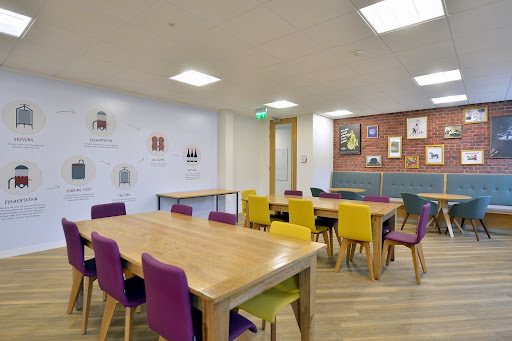
1. Refreshments for the moving team
Congratulations, you’ve made it to moving day! But remember that relocation can be thirsty work. Particularly for those who are planning on moving during warmer months, make sure to set some of your budget aside for refreshments to keep your moving team energised. The more you’ve stocked up you are on drinks and snacks, the more motivated they’ll be to get the job done.
2. Ensure tech equipment is moved and installed
Make sure your tech equipment is moved in and installed before you start letting your staff into the new office, otherwise, you might risk halting regular business operations – which can be costly. To prevent the risk of some unhappy customers and clients, and to reduce downtime, get this organised as soon as you can.
3. Organise furniture in the new office, based on the floor plan
Armed with your floor plan, place your new office furniture accordingly. To make the task easier, you could partner with an office refurbishment company – such as ourselves – who will deliver and assemble the furniture for you. Not only this, our team will get rid of all the packaging waste too, so that you can focus on getting your new workspace visitor-ready.
4. Preparing for staff arrival
Before your staff burst through the doors, provide them with keys or fobs for the new office. You’ll also need to reinforce the new office address to avoid anyone showing up at the old office – trust us, it can happen.
Post-move

1. Update website information
Once you’ve got settled in, make sure that any of your website visitors are directed to the right place by updating your new address. The same goes for any business cards or fliers that you’re planning on issuing to your staff.
2. Check furniture
Check your office furniture carefully for any signs of damage after everything’s been unpacked. When you rely on a removal or fit out company to help with this process, there should be less chance of this happening. However, this step is essential for making sure that you’re ready to open the doors to your clients and visitors.
3. Send back keys, fobs and passes to old office
Avoid unnecessary clutter building up in your new office – and prevent staff from bringing the wrong key into work – by making sure that any old fobs and passes are sent back to your previous landlord.
4. Celebrate!
We’re not saying that you should start dancing on your brand new office desks – but hey, if that’s your style, don’t let us stand in the way. After all the hard work that both you and your team has put into the move, you’re all certainly deserving of a treat; an office relocation is a business milestone that shouldn’t be overlooked.
Frequently asked questions about office relocation
What are the benefits of office relocation?
We could go on forever about the benefits of office relocation. Here are some of the best reasons to consider office relocation for your business:
- Allows you to expand your business
- Allows you to downsize your space if required
- It can help improve employee morale and safety
- Access new markets for your business
- Reduce commute times for both yourself and employees
- Potentially be closer to clients
- Cost-savings
- Enhances your brand’s reputation
How to announce an office relocation
Although an office relocation may sound like the best move as the decision maker, in rare cases, employees may be concerned. We advise easing their worries and answering any questions they may have. Here are some tips to effectively communicate your plans for an office relocation:
- Organise a date and time to announce the office relocation
- State all of your reasons why the relocation is of benefit to the business as well as employees
- Leave space for employees to come forward with their questions and concerns
- Address any potential issues with effective solutions for both yourself and the employee – will the relocation make it harder for your employees to commute to? If so, can hot desking office design, a hybrid or remote working approach work for your business?
- Be sensitive towards employees about the move, and ensure systems are in place to make the transition seamless.
Need a helping hand with your office relocation? You can rely on our team of design and fit out experts to get the job done, without the stress. Contact us today on 0845 340 4194 for expert help with a relocation project, or email us on info@diamondinteriors.co.uk to get your own handy copy of the office relocation checklist.
